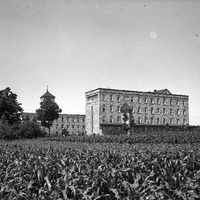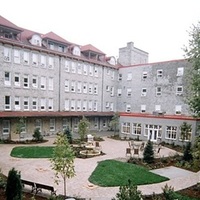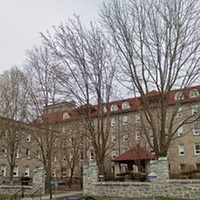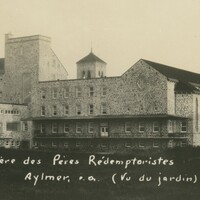Le Monastère des Pères Rédemptoristes-The Redemptorist Monastery (1938)
Dublin Core
Title
Le Monastère des Pères Rédemptoristes-The Redemptorist Monastery (1938)
Description
LE MONASTÈRE DES PÈRES RÉDEMPTORISTES (1938) 161, rue Principal
Situé au cœur du Vieux-Aylmer, cet impressionnant complexe de pierre se distingue par son importance historique et sa présence architecturale. En 1909, l'entrepreneur Robert W. Wright y installe de grandes serres pour soutenir son commerce florissant de fleurs et de plantes. Une voie ferrée privée reliée à la ligne principale du Canadien Pacifique assurait un approvisionnement régulier en charbon pour chauffer les serres.
En 1937, la propriété a été achetée par les Pères Rédemptoristes, qui ont construit le vaste scolasticat en pierre conçu par l'architecte renommé Joseph Aimé Poulin de Sherbrooke, au Québec. Le bâtiment a été parfaitement intégré à la maison John Egan de 1840, formant ainsi un ensemble architectural cohérent. Entre 1938 et 1968, le monastère a accueilli une communauté d'environ 130 prêtres, moines et étudiants. Le scolasticat permettait aux jeunes hommes d'acquérir une formation supérieure avant d'entrer au séminaire. Le bâtiment est un exemple significatif de l'architecture institutionnelle religieuse du XXe siècle et contribue au patrimoine bâti d'Aylmer.
Aujourd'hui, l'ancien monastère a été réaffecté en résidence privée pour personnes âgées et des extensions ont été construites qui s'intègrent à l'architecture existante. La résidence Chartwell Monastère d'Aylmer est imprégnée d'histoire et poursuit sa vie dans un cadre patrimonial préservé.
THE REDEMPTORIST MONASTERY (1938) 161, rue Principale
Located in the heart of Old Aylmer, this impressive stone complex stands out for its historical significance and architectural presence. In 1909, entrepreneur Robert W. Wright established large greenhouses on the site to support his flourishing flower and plant business. A private railway track connected to the Canadian Pacific main line, ensured a steady coal supply to heat the greenhouses.
In 1937, the property was purchased by the Redemptorist Fathers, who constructed the expansive stone scholasticate designed by renowned architect, Joseph Aimé Poulin of Sherbrooke, Québec. The building was seamlessly incorporated into the existing 1840 John Egan House, forming a cohesive architectural ensemble. Between 1938 and 1968, the monastery housed a community of approximately 130 priests, monks, and students. The scholasticate enabled young men to acquire a higher education before entering the seminary. The building is a significant example of 20th-century religious institutional architecture and contributes to Aylmer’s built heritage.
Today, the former monastery has been repurposed as a private seniors' residence with extensions built that blend with the existing architecture. The Chartwell Monastère d’Aylmer residence is steeped in history, continuing its life within a preserved heritage setting.
Source: Enid Page, Archives APA-AHA, mai 2025
Situé au cœur du Vieux-Aylmer, cet impressionnant complexe de pierre se distingue par son importance historique et sa présence architecturale. En 1909, l'entrepreneur Robert W. Wright y installe de grandes serres pour soutenir son commerce florissant de fleurs et de plantes. Une voie ferrée privée reliée à la ligne principale du Canadien Pacifique assurait un approvisionnement régulier en charbon pour chauffer les serres.
En 1937, la propriété a été achetée par les Pères Rédemptoristes, qui ont construit le vaste scolasticat en pierre conçu par l'architecte renommé Joseph Aimé Poulin de Sherbrooke, au Québec. Le bâtiment a été parfaitement intégré à la maison John Egan de 1840, formant ainsi un ensemble architectural cohérent. Entre 1938 et 1968, le monastère a accueilli une communauté d'environ 130 prêtres, moines et étudiants. Le scolasticat permettait aux jeunes hommes d'acquérir une formation supérieure avant d'entrer au séminaire. Le bâtiment est un exemple significatif de l'architecture institutionnelle religieuse du XXe siècle et contribue au patrimoine bâti d'Aylmer.
Aujourd'hui, l'ancien monastère a été réaffecté en résidence privée pour personnes âgées et des extensions ont été construites qui s'intègrent à l'architecture existante. La résidence Chartwell Monastère d'Aylmer est imprégnée d'histoire et poursuit sa vie dans un cadre patrimonial préservé.
THE REDEMPTORIST MONASTERY (1938) 161, rue Principale
Located in the heart of Old Aylmer, this impressive stone complex stands out for its historical significance and architectural presence. In 1909, entrepreneur Robert W. Wright established large greenhouses on the site to support his flourishing flower and plant business. A private railway track connected to the Canadian Pacific main line, ensured a steady coal supply to heat the greenhouses.
In 1937, the property was purchased by the Redemptorist Fathers, who constructed the expansive stone scholasticate designed by renowned architect, Joseph Aimé Poulin of Sherbrooke, Québec. The building was seamlessly incorporated into the existing 1840 John Egan House, forming a cohesive architectural ensemble. Between 1938 and 1968, the monastery housed a community of approximately 130 priests, monks, and students. The scholasticate enabled young men to acquire a higher education before entering the seminary. The building is a significant example of 20th-century religious institutional architecture and contributes to Aylmer’s built heritage.
Today, the former monastery has been repurposed as a private seniors' residence with extensions built that blend with the existing architecture. The Chartwell Monastère d’Aylmer residence is steeped in history, continuing its life within a preserved heritage setting.
Source: Enid Page, Archives APA-AHA, mai 2025
Citation
“Le Monastère des Pères Rédemptoristes-The Redemptorist Monastery (1938),” APA/AHA, accessed November 28, 2025, https://heritagediversity.com/apa/items/show/4171.





